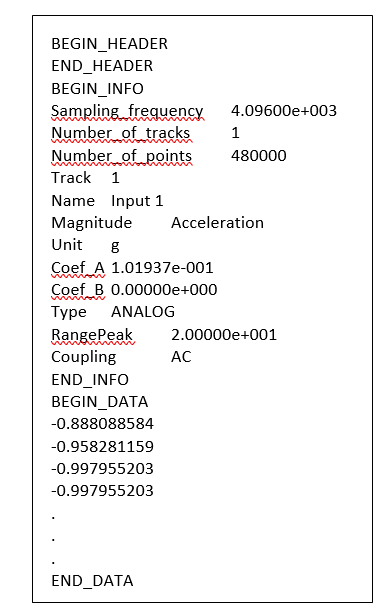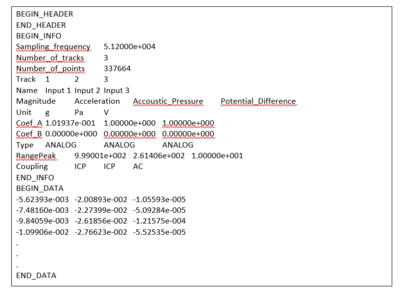Difference between revisions of "Description of .txt export"
(Created page with "==How to convert a signal data from Text to a compatible file for NVGate ?== NVGate allows importing signal from a text file. It’s a very convenient feature to import signa...") |
|||
| Line 5: | Line 5: | ||
Here is an example of text file for 1 channel and a brief description of its content: | Here is an example of text file for 1 channel and a brief description of its content: | ||
[[File:txt export.PNG| | [[File:txt export.PNG|left]] | ||
Sampling_frequency 4.09600e+003 Must be one of the sampling frequency available at NVGate | Sampling_frequency 4.09600e+003 Must be one of the sampling frequency available at NVGate | ||
Revision as of 09:30, 27 July 2021
How to convert a signal data from Text to a compatible file for NVGate ?
NVGate allows importing signal from a text file. It’s a very convenient feature to import signal from any source. On the contrary the text file must be setup according to standards NVGate design. The easier way to do is to record a file at NVGate and export it to check its content.
Here is an example of text file for 1 channel and a brief description of its content:
Sampling_frequency 4.09600e+003 Must be one of the sampling frequency available at NVGate Number_of_tracks 1 Number of Track Number_of_points 480000 Number of Point : must be a multiple of 256 Track 1 Track number Name Input 1 Track Label Magnitude Acceleration Magnitude of Track Unit g Unit Coef_A 1.01937e-001 Conversion Parameter from Unit to SI Unit : Coef_B 0.00000e+000 Unit = Coef_A * Unit_SI + Coef_B Type ANALOG Analog Channel RangePeak 2.00000e+001 Range Peak at SI Unit Coupling AC Coupling END_INFO BEGIN_DATA -0.888088584 Data… as many line as “Number of Point

